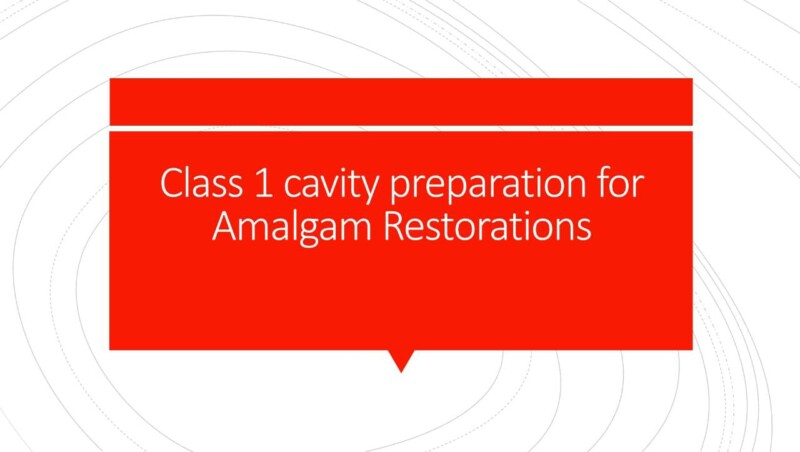Principles of Cavity Preparation for Amalgam Restorations
1) OUTLINE FORM
-Area of tooth surface that will be included within the outline of the cavity.
-The outline form of the prepared cavity is approached from some central position of the tooth surface, extending laterally to establish the outline.
-External outline form consists of smooth curves, straight lines & rounded angles.
-Occlusal cavosurface angle should be between 85 to 95 degrees.
-All unsupported enamel rods must be removed.
2) REVERSED CURVE
-Conserving the sound tooth tissue which will preserve the triangular ridge of the affected cusps.
– Flare of the proximal wall leaves the tangent to the outer tooth surface at 85 to 95 degrees angle.
(Create maximum resistance form)
(A design for proximo-occlusal restorations)
-Unnecessary loss of tooth tissue must be avoided
-Adequate thickness of amalgam restorations should be attained for strength.
-Axial walls should be positioned uniformly to the dentin.
-Depth of proximal dentinoenamel junction is slightly greater than the diameter of bur used.
-Axial wall in an occlusogingival direction is in flat plane / parallel / slightly divergent with the axis of the tooth (occlusogingival)
-Minimum buccolingual dimension of axial wall depends on external outline of buccal and lingual proximal margins.
3) RESISTANCE FORM
-Shape given to the cavity to afford a seat for filling which enables it to withstand the force of mastication.
-The pulpal & gingival walls should be flat with slight rounded angles and should be perpendicular to the long axis of the tooth.
4) RETENTION FORM
-Preventing the filling from displacement.
-Shaping of the opposing walls is strictly parallel or slightly undercut.
-The proximal box should have inversely tapered walls.
-The buccal & lingual proximal walls need to have divergence to produce sound margins & grooves within proximal dentin walls.
-Dovetail is done on the occlusal surface.
5) CONVENIENCE FORM
-Shaping the cavity that renders the form more convenient to remove the caries & placing the filling materials.
-For instrumentations, to remove defects, for cavity refinement & restorations placement.
-In amalgam restorations, it gives access to condensing instruments, smooth curves & rounded angles of the external outlines.
6) REMOVAL OF REMAINING CARIOUS DENTIN & PULP PROTECTION
-Caries removal begins after establishing the outline, by extending laterally at the pulpal floor depth.
-Small carious portion is completely removed while showing the outline form.
-Deepening of the cavity beyond that required is not needed.
-All sound tooth tissue should be retained.
7) FINISH OF THE ENAMEL WALLS & MARGINS
-Enamel wall & amalgam interface should form 90 degree angle (butt-type junction)
-Amalgam with the greatest bulk will provide maximum strength.
-Finishing of the enamel walls and margins must adhere to restoration in paralleling the enamel rods at the dentinoenamel junction.
-Preparation of obtuse & acute cavosurface angle of enamel if unsupported by healthy dentin will decrease the life of the restorations.
Additional Resistance & Retention Form
– Usually required in larger cavities.
– Increase retention form = increase resistance form
– Grooves / locks / coves / pins / slots / amalgam pins = to increase retention form.
– Bonding of amalgam increases retention & resistance form (not substitute of primary mechanical retention)
Final Procedures
Cavity preparation is examined from all angles before restoration is made,
-Complete caries removal
-Proper depth
-Correct angles between cavity preparation & amalgam
-Absence of any debris.
PRACTICAL NOTES
The outline form of the cavity depends on the number of cusps.
-Lower 1st molar : STELLATE
-Lower 2nd molar: CROSS
-Lower 1st premolar: SNAKE EYE / SMILEY
-Lower 2nd premolar: Y-SHAPED
-Upper molars: KIDNEY / OVAL SHAPE / H-SHAPED (if ridge is weak)
-Upper premolars: DUMBBELL / BUTTERFLY
Contributor – Medico Umairah Zulkifli




